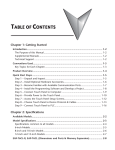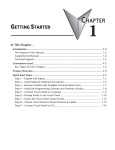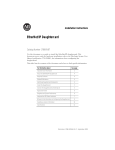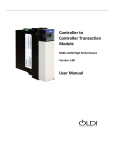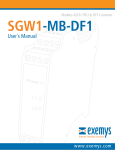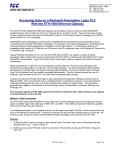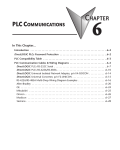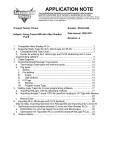Download EtherNet/IP Design and Troubleshooting
Transcript
EtherNet/IP Design and Troubleshooting Course Code: CCP178 Duration: 3 Days Course Purpose: This course prepares you to successfully design and configure an efficient EtherNet/IPt (Industrial Protocol) network by managing both the bandwidth requirements for a project and the number of connections on the network. You will configure a Stratix 6000 switch for viewing and controlling network traffic, restricting traffic overload, and protecting against unauthorized device access. This course also prepares you to effectively resolve the breakdown in communications between a controller and the devices it is controlling. You will troubleshoot an EtherNet/IP network's media components and use web-based technologies imbedded within multiple EtherNet/IP devices to monitor the health and status of the EtherNet/IP network. Who Should Attend: Individuals responsible for designing and configuring a new EtherNet/IP network or modifying and troubleshooting an existing EtherNet/IP network should attend this course. Topic Outline: Day 1 Designing an EtherNet/IP Cable System Optimizing an EtherNet/IP Network Pinging a Module’s EtherNet/IP Address Configuring and Modifying EtherNet/IP Addresses Using RSLinx® Software Day 2 Configuring and Modifying EtherNet/IP Addresses Using RSLogix™ 5000 Software Configuring and Modifying EtherNet/IP Addresses Using BOOTP-DHCP Server© Software Establishing EtherNet/IP Connections to Remote Devices Producing and Consuming Data over an Ethernet/IP Network Day 3 Communicating between Multiple Controllers on an Ethernet/IP Network Using a Message Instruction Configuring the Stratix 6000 Ethernet Switch Troubleshooting an EtherNet/IP Network’s Media Components Monitoring an EtherNet/IP Network Using Web-Enabled Technologies CCP178 0511 AUS EtherNet/IP Design and Troubleshooting Course Code: CCP178 Duration: 3 Days Prerequisites: To successfully complete this course, students must be able to perform basic Microsoft® Windows tasks such as using a mouse, opening and saving files, and moving windows. Students should also have successfully completed one or more of the following courses (or demonstrate equivalent experience): Level 3: RSLogix 5000 Development & Programming of ControlLogix Projects (Course No. CCPAUS143) Student Materials: To enhance and facilitate your learning experience, the following materials are provided as part of the course package: Student Manual, which contains the key concepts, definitions, and examples presented in the course and includes several hands-on exercises. EtherNet/IP Procedures Guide, which provides all of the steps required to complete task common to designing and configuring devices to communicate over an EtherNet/IP network. By following the procedures in this job aid, students can immediately apply what is learned in the course to their own job. EtherNet/IP Documentation Reference Guide, which contains several relevant technical publications. This searchable, electronic resource contains the most frequently referenced information and is a quick and efficient on-the-job resource. Hands-On Practice: Hands-on practice is a necessary part of learning and this course offers hands-on opportunities to configure a project that will optimize network communications. Students will design a cable system in accordance with established EtherNet/IP requirements that support fictional application requirements. Students will assign IP and gateway addresses and subnet masks, configure a controller and local and remote I/O devices for messaging and control, and optimize network performance. Students will have the opportunity to practice the skills presented in class using the following Rockwell Automation products: 1756 ControlLogix® controller, EtherNet/IP and digital I/O modules 1769 CompactLogix™ controller, EtherNet/IP and digital I/O modules 1794 FlexLogix™ EtherNet/IP adapter and analogue module Stratix 6000 Ethernet Switch PanelView™ Plus 600 terminal CCP178 0511 AUS



